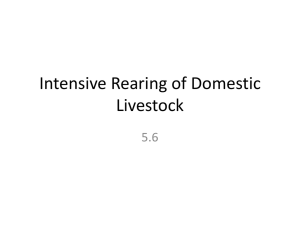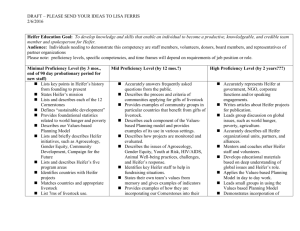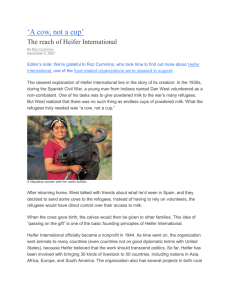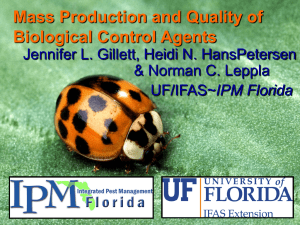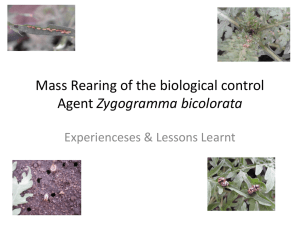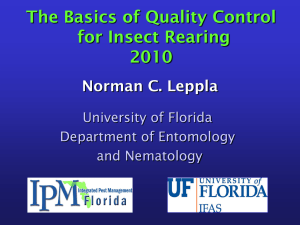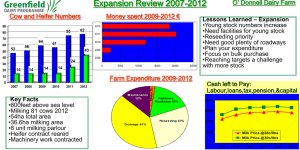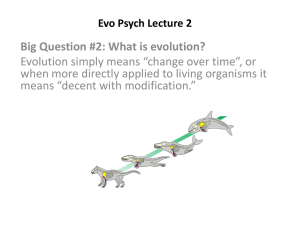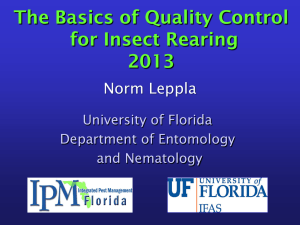Heifer Rearing
advertisement
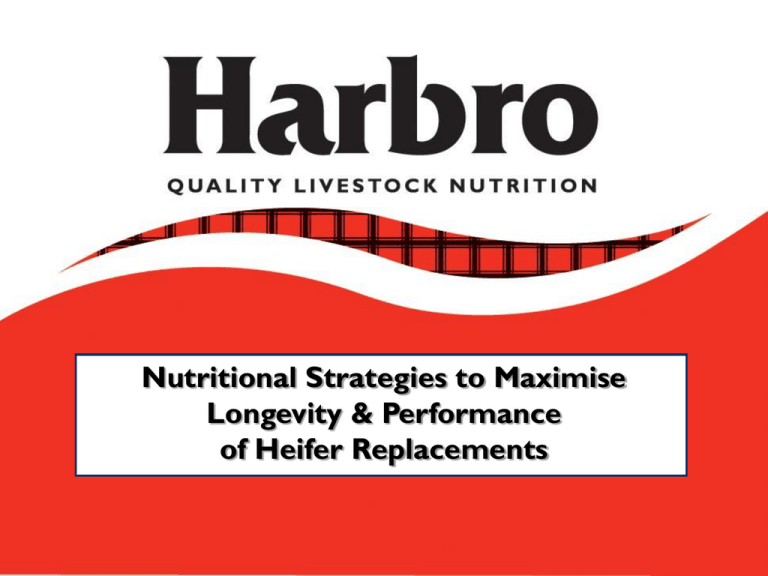
Nutritional Strategies to Maximise Longevity & Performance of Heifer Replacements Heifer Rearing The issues • Heifer rearing is the 2nd biggest cost in milk production • It takes 1.3 lactations to cover this cost • 20% of heifers do not reach their first lactation • 40% of heifers do not enter a second lactation These failures are mainly due to: • Poor calf management – housing, health etc. • Poor initial growth and bone development • Poor rumen development Heifer Rearing Heifer Rearing The importance of Colostrum • Naïve calves • Antibodies • Growth promoters – body and mammary Heifer Rearing Heifer Rearing Antibody concentration Passive immunity (colostrum) High risk period 1d 14 d Active immunity (immune system) Time Antibodies from the colostrum protects the calf until their own immune systems are fully functional. Heifer Rearing Heifer Rearing The importance of Colostrum • Naïve calves • Antibodies • Growth promoters – body and mammary However: • 50% of calves do not take in sufficient colostrum and often it is fed too late • Large variation in colostrum quality (Age, immunity, yield, length of dry period, mineral and protein status) • 80% of colostrum less than recommended minimum level of antibodies (60 g IgG/l) Heifer Rearing Heifer Rearing Colostrum Immunoglobulin Concentration Ig (g/L) Mean SE Min Max IgG 40.96 10.23 14.5 94.8 IgA 1.66 0.99 0.5 4.4 IgM 4.32 2.84 1.1 21.0 Heifer Rearing Heifer Rearing What colostrum to feed to who? • Avoid feeding heifer colostrum • Ideal colostrum is from cows in their 3rd lactation • Measure colostrum quality using colostrometer • Monitor calf antibody levels – ZST Heifer Rearing Heifer Rearing When to feed colostrum? • 3 litres in first 2 hours of life = 20 mins continuous suckling • Minimum of 6 litres in first 6 hours of life • 90% chance of survival Heifer Rearing Heifer Rearing • Low antibody levels = 6x more likely to die in first 6 months • 57% of all calf deaths are directly linked to poor antibody levels • Poor immunity = gut damage and poor performance Heifer Rearing Heifer Rearing Calf Feeding Aims • Maximise rumen development to maximise calf growth • Utilise calf efficiency for optimum growth Age 0-10 weeks 3 mnths 4 mnths 6 mnths 8 mnths 10 mnths 12 mnths 14 mnths 16 mnths 18 mnths 21 mnths Feed Efficiency (%) 56 26 24 28 12 10 9.4 9.2 8.9 8.3 7.3 • Wean at 6 weeks • Produce heifers that are “fit not fat” Heifer Rearing Heifer Rearing Feeding Milk • Do not feed antibiotic and high cell count milk to calves • Calf Milk Replace provides a consistent supply of quality milk until the rumen is developed • Feed a high protein (24%), medium fat (17%) milk replacer such as Harbro Premium Plus to optimise bone and protein growth without putting on fat Harbro Milk Replacers Heifer Rearing Key Features • Carefully selected milk (whey) solids with maximum nutritional value • Balanced blend of vegetable fats and oils, homogenised and emulsified for maximum digestibility • Full supplement of vitamins, minerals and trace elements. Enhanced levels in Premium Plus. • Nuklospray – a special complex of co-spray dried pre digested (hydrolysed) protein and dairy products which are more readily digested and absorbed • Acidified to ensure freshness for up to 24 hours Premium PlusPremium Plus For fast frame growth, allowing heifers to achieve target weights to bulling and beyond Protein Oil Ash Fibre - 24% - 17% - 7.5% - 0.05% Heifer Rearing Economy Economy Enables beef and dairy calves to achieve growth rates required for lifetime performance Protein Oil Ash Fibre - 22% - 15% - 7.0% - 0.05% Concentrated Milk Protein Whey vs skimmed milk protein ? Protein (% of dry matter) Immunoglobulin (% of protein) % of protein as … - Casein protein - Whey protein Skimmed Milk 26 Whey 13 Colostrum 58 <1.5 7.5 35-45 80 20 0 100 35 65 • Whey more easily absorbed than Casein – Body Building • Casein clots and makes calves feel full – Whey does not clot and therefore has higher DMI Heifer Rearing Feeding the rumen Heifer Rearing Feeding the rumen Heifer Rearing Heifer Rearing Developing the rumen papillae • Feed grain – to produce essential VFA’s and drop rumen pH • Feed “scratchy fibre” to stimulate the rumen wall • Allow access to dry feed from as young as 3 days old • Limit milk to a maximum of 4 litres/day • Provide unlimited access to water • Enough to cover a tennis court Heifer Rearing Heifer Rearing Buttercup Calf Starter • High in slow release starch • Rumen Friendly Concept – Cut Grain • Yea-Sacc – stimulates the growth of rumen microbes and buffers rumen pH • Fish Oils – increases calf vitality and boosts immunity • Biotin – promotes strong hoof growth Heifer Rearing Heifer Rearing Weaning • Start to wean when the calf is eating 1kg of Calf Starter over 3 consecutive days • Reduce milk and increase Calf Starter over 10 days • Allow continued free access to straw and water Heifer Rearing Heifer Rearing Heifer Feeding Aims • Grow Heifers steadily to achieve the optimum weight at breeding 350-420kg liveweight (55% of mature weight) • Calve at 22-24 months old • Calve with good condition • Calve at the correct body weight (90% of mature weight) Heifer Rearing Heifer Rearing Heifer Feeding Key periods Target ADG (kg/d) • 3 – 8 months: Developing the Mammary Gland 0.65 • 8 – 13 months: Puberty and growing frame 0.85 • 13 – 16 months: Breeding period 0.85 • 16 – 23 months: Pregnancy period 0.80 • 23 – 24 months: Month before calving Heifer Rearing Heifer Rearing 8000 305-day milk yield (kg) 7800 7600 7400 7200 7000 6800 6600 6400 6200 6000 600 700 800 900 1000 Average daily gain (g/d) 1100 1200 Heifer Rearing Heifer Rearing Effect of Age at Calving on Replacements Heifer Rearing Heifer Rearing Effect of Age at Calving on Fertility and Production Total Milk Value @ 25ppl £6258 £5099 £4168 £2008 Heifer Rearing Heifer Rearing Thank You

